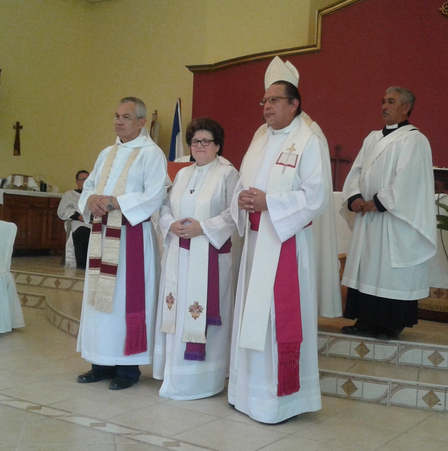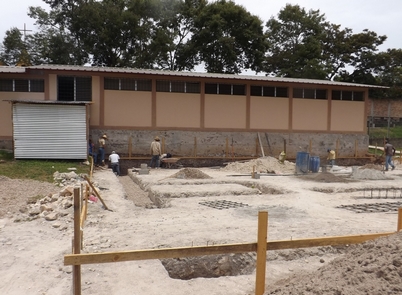David Grover’s “Faces of Honduras”: Milking a cow.
Letter from the Mission Field (August 15, 2015)

Greeting everyone! I hope you are enjoying your summer!
Earlier this year in April, I had a rather serious medical adventure. During my visit to the Church of Emmanuel in Roatán before Easter, I began to get a series of intense headaches, which eventually put me into the San Jorge Hospital in Tegucigalpa. I was diagnosed with severe hypertension, at risk for a stroke or heart attack. Subsequently, I flew to Boston to continue my treatment. Since then, I have returned to Honduras and my health is much better.
Much has happened here since the last newsletter. I continue to be very busy.
The most important update is that Fr. Roberto Martínez, whom many of you met during our trip to New England last October, has been promoted to dean of the Omoa/ Puerto Cortes deanery. (The Diocese of Honduras is subdivided into eleven deaneries). Unfortunately for me, he will be moving away to the north coast in September or October. But may God’s blessings be with him in his new job. (See map on the right for all locations mentioned.)
As for design news, two new major projects are underway: the Zamorano Retreat Center near the town of Zamorano, located on the other side of the mountains to the east of Tegucigalpa and a new facility for St. John’s Bilingual School in Siguatepeque.
The work on the Buen Pastor Church in Santa Maria and Church Emmanuel in Roatán continues slowly, but progress is being made. The Good Shepherd Church from Lake Wales, Florida, sent a team in June under the leadership of Father Tom Seitz. They helped paint the interior and conducted a bible school for the kids.
And finally, regarding the Ministry of Presence, some of you have donated money to help kids go to school. We have provided partial scholarships for four kids at Church of the Annunciation in Rincón de Dolores, Fr. Roberto’s church. Special thanks to Claire Dewey, Paloma Lee and others for your donations.
Peace and all goodness to you,
Jack
Jack
Father Roberto Martínez Appointed Dean of Omoa/ Puerto Cortes Deanery
 |
| Father Roberto Aaròn Martínez (right) with Vaike Marika Madison (center) and Jose Luis Medoza (left) at the Honduran Diocesan Convention 2015. |
Father Roberto, who came with me to the United States last October to preach in various churches, has been appointed Dean of Omoa/Cortes. His new deanery has approximately eleven churches and missions. He will be working with Ana Reid, our other SAMS missionary from Christ the Redeemer Church in Danvers, MA, who is currently living in Omoa.
New School Planned for Siguatepeque: Pro bono design by Inscape Publico
St. John’s Bilingual School is moving forward with plans to build a new facility on the vacant property behind the existing school and church in Siguatapeque.
 |
| From left to right, Architect Stefan Schwarzkopf, new School Superintendant Steven Robinson, Architect Greg Kearley, Jack Melvin and Bishop Lloyd Allen |
Inscape Publico, the non-profit arm of the architecture firm Inscape Studios in Washington D.C., is helping us with the design. Greg Kearley AIA and Stefan Schwarzkopf AIA have visited the existing school and site several times this past year and have developed a campus master plan for us.
This coming academic year, the St. John’s School urgently needs more space for next year’s students. The school currently goes to fifth grade. Each year, it adds an additional grade to keep up with the incoming students. At this point, there is no more room in the existing church buildings.
Accordingly, Greg Kearly and his team have fast-tracked us a set of construction documents for a new cafeteria, which will serve as three temporary new classrooms, until the rest of the school is finished.
The work on the cafeteria/classroom has already begun.
 |
| Master plan for St. John’s Bilingual School in Siguatepeque. The new school buildings are in color. The existing school and church are in upper right in gray. |
St. John’s is part of a diocesan network of bilingual schools, each located in a major city. The students graduate not only with a good education but also fluent in English, which gives them an advantage in a tight job market. Because of Honduras’ proximity to the robust United States economy, businesses are very eager to hire bilingual employees.
 |
| Reverenda Madison Vaike, the school chaplain, leads the kids in the ground breaking service. |
 |
| The workers begin laying the foundation. |
